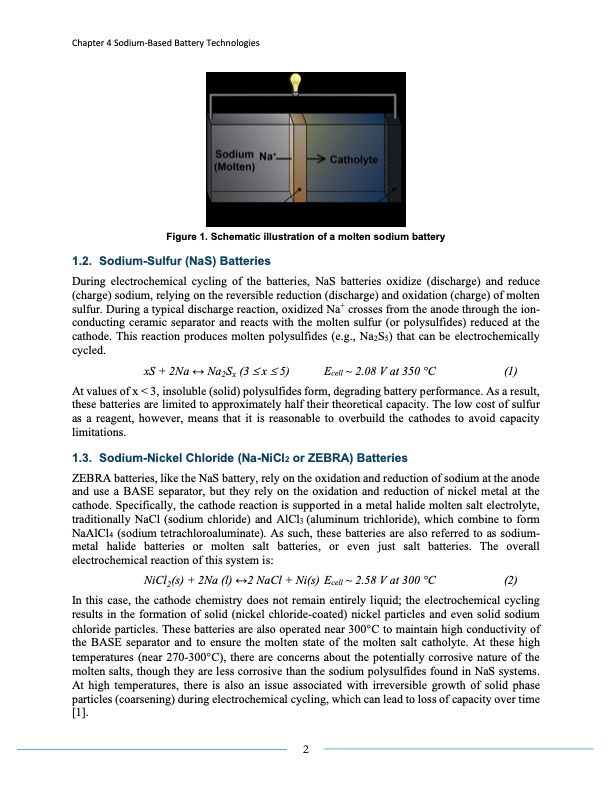
PDF Publication Title:
Text from PDF Page: 002
Chapter 4 Sodium-Based Battery Technologies Figure 1. Schematic illustration of a molten sodium battery 1.2. Sodium-Sulfur (NaS) Batteries During electrochemical cycling of the batteries, NaS batteries oxidize (discharge) and reduce (charge) sodium, relying on the reversible reduction (discharge) and oxidation (charge) of molten sulfur. During a typical discharge reaction, oxidized Na+ crosses from the anode through the ion- conducting ceramic separator and reacts with the molten sulfur (or polysulfides) reduced at the cathode. This reaction produces molten polysulfides (e.g., Na2S5) that can be electrochemically cycled. xS + 2Na ↔ Na2Sx (3 ≤ x ≤ 5) Ecell ~ 2.08 V at 350 °C (1) At values of x < 3, insoluble (solid) polysulfides form, degrading battery performance. As a result, these batteries are limited to approximately half their theoretical capacity. The low cost of sulfur as a reagent, however, means that it is reasonable to overbuild the cathodes to avoid capacity limitations. 1.3. Sodium-Nickel Chloride (Na-NiCl2 or ZEBRA) Batteries ZEBRA batteries, like the NaS battery, rely on the oxidation and reduction of sodium at the anode and use a BASE separator, but they rely on the oxidation and reduction of nickel metal at the cathode. Specifically, the cathode reaction is supported in a metal halide molten salt electrolyte, traditionally NaCl (sodium chloride) and AlCl3 (aluminum trichloride), which combine to form NaAlCl4 (sodium tetrachloroaluminate). As such, these batteries are also referred to as sodium- metal halide batteries or molten salt batteries, or even just salt batteries. The overall electrochemical reaction of this system is: NiCl2(s) + 2Na (l) ↔2 NaCl + Ni(s) Ecell ~ 2.58 V at 300 °C (2) In this case, the cathode chemistry does not remain entirely liquid; the electrochemical cycling results in the formation of solid (nickel chloride-coated) nickel particles and even solid sodium chloride particles. These batteries are also operated near 300°C to maintain high conductivity of the BASE separator and to ensure the molten state of the molten salt catholyte. At these high temperatures (near 270-300°C), there are concerns about the potentially corrosive nature of the molten salts, though they are less corrosive than the sodium polysulfides found in NaS systems. At high temperatures, there is also an issue associated with irreversible growth of solid phase particles (coarsening) during electrochemical cycling, which can lead to loss of capacity over time [1]. 2PDF Image | SODIUM-BASED BATTERY TECHNOLOGIES CH 4

PDF Search Title:
SODIUM-BASED BATTERY TECHNOLOGIES CH 4Original File Name Searched:
ESHB_Ch4_Sodium_Spoerke-1.pdfDIY PDF Search: Google It | Yahoo | Bing
Salgenx Redox Flow Battery Technology: Salt water flow battery technology with low cost and great energy density that can be used for power storage and thermal storage. Let us de-risk your production using our license. Our aqueous flow battery is less cost than Tesla Megapack and available faster. Redox flow battery. No membrane needed like with Vanadium, or Bromine. Salgenx flow battery
| CONTACT TEL: 608-238-6001 Email: greg@salgenx.com | RSS | AMP |